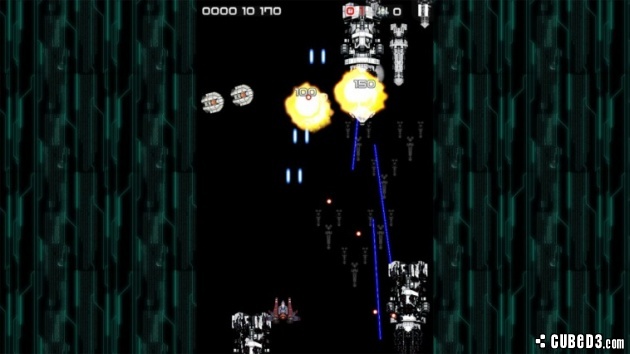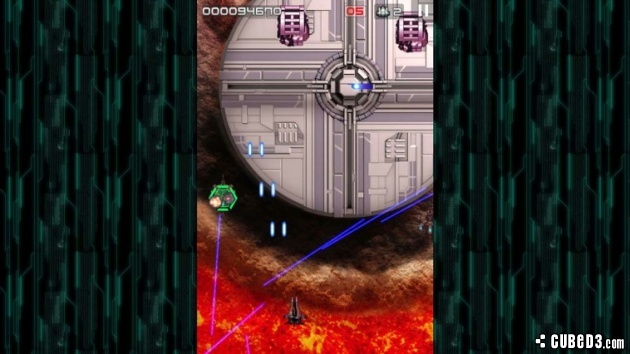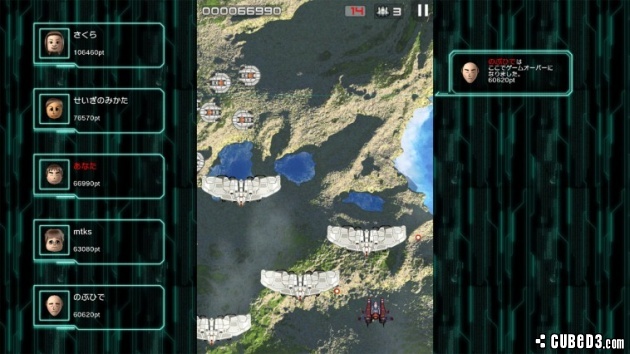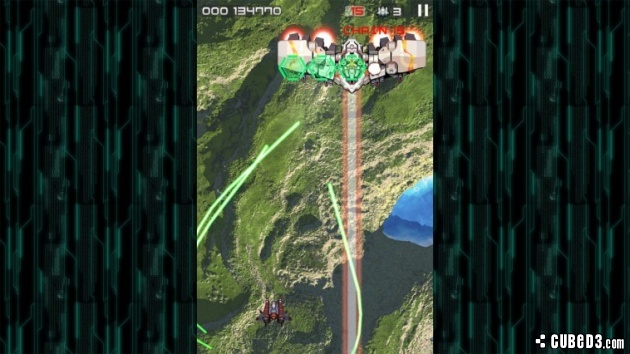Gaiabreaker (Wii U) Review
By Lex Firth  06.09.2014
06.09.2014

The top-down shoot 'em up as a genre may have dwindled in popularity in recent years, but it remains an important chapter of gaming history. Having been around since the dawn of video gaming and predating even Nintendo's foray into the industry, one might expect these games to have evolved greatly to adapt to the modern video game world. Gaiabreaker attempts to bring some new ideas to the table whilst paying tribute to the arcade-fillers of the 80s and 90s, but does it do enough to warrant a purchase?
Gaiabreaker is a vertically-scrolling shooter in the vein of classics such as Xevious and TwinBee. Developed using the Nintendo Web Framework, it is the first console game from Ubiquitous Entertainment, a Japanese company more used to developing for mobile devices. The game is definitely evocative of a smartphone app, with simple touch screen controls and even a portrait-orientated playing field.
This unusual screen setup is initially jarring and leads to one of the game's most glaring faults: on the GamePad, it's simply too uncomfortable to play for long. The controller is held sideways with movement mapped to the analogue stick and firing mapped to the A button. While a good idea in practice (many other shoot 'em ups also use a portrait screen design), the controller is simply too heavy to make this worthwhile and too much time spent in this position has the potential to become quite painful; the only alternative for Off-TV play is a button that switches the controls to a horizontal format, which also shrinks the screen to fit the GamePad's smaller dimensions to the point where it's difficult to see what's going on. In other words, GamePad play boils down to a choice between hand cramps and eye strain.

When playing on the TV, the game is functional but still runs into some issues. It sometimes seems to struggle to run, with massive slowdown on the loading screens and even some noticeable lag during gameplay, which can occasionally lead to unfair deaths - this is a serious problem, given how unforgiving Gaiabreaker is. Running out of lives sends the player straight back to the start, with the only way of reaching the next level being playing from level one; the goal here is to survive to the end of the six stages using a limited number of lives. A secondary mode allows players to select individual stages to practise and aim for a high score; these stages do, however, have to be unlocked in the main mode first, meaning that newcomers to the genre may struggle even to see more than half the content that the game has to offer.
Although the game caters towards veterans of shoot 'em ups in its difficulty, there is very little else to stimulate the more hardcore shooter fans. Compared to the genre's more famous titles, Gaiabreaker seems distinctly lacking in many staple features. For instance, the game's spaceship only features two weapons: a weak laser blast (which, it should be noted, lacks the capacity for rapid-fire; expect to be mashing the A button), with a slightly more powerful homing shot, which only appears when the ship stops moving. Where TwinBee's intuitive target shooting-based power-up system and R-Type's options both served to liven up their respective games, Gaiabreaker feels distinctly less interesting with no game-changing mechanics.

Tradition is also broken with this game's decision to limit the movement of the spaceship. While in most shoot 'em ups the player is free to move anywhere on the screen, Gaiabreaker's player sprite is restrained to the bottom of the screen, with only left and right movement possible. As a result, not only does pulling off impressive dodges become much more difficult, but the game starts to feel slow, restricted and ultimately quite boring.
While Gaiabreaker does indeed omit some of the more agreeable staples of the franchise, it does its best to add some new features with the help of the Wii U. One of these is the inclusion of touch screen controls on the GamePad, which are a welcome reprieve from the discomfort of playing in portrait orientation; however, even this more comfortable control scheme is not without fault. The spaceship is moved by dragging the stylus (or a finger) across the touch screen, while shooting is carried out with a tap - this means that it's physically impossible to move and shoot at the same time and so the most comfortable control scheme turns out to be the least effective in gameplay.

The game also makes an effort to integrate Miiverse and, although it has to be switched on from the options menu, it's a worthwhile addition for high score chasers. When activated, the highest scores from other users will appear on the side of the TV screen in order to provide an incentive for those who are inclined to return to the game again and again to improve their performance. It's here that Gaiabreaker's mission statement becomes far more apparent: it aims to satisfy a particular type of player. Those who are happy to replay content over and over again in the aim of breaking into the leaderboards will get their money's worth, but one playthrough of each of the game's meagre offering of six stages is hardly worth the £9.89 entry fee.
Ultimately, Gaiabreaker is by no means a bad game - despite the occasional technical issue, it's overall functional and behind its strange design choices in the face of convention lies a serious attempt at using the console's unique features, as well as rejuvenating the genre with new control schemes. However, that simply isn't enough to rescue what is overall a mediocre experience through and through. High score chasers may indeed find a little more on offer here than casual players, but even the most hardcore lovers of shoot 'em ups will struggle to be captivated.

Cubed3 Rating
Subpar
Though its competition on the Nintendo Wii U eShop is limited, it's certainly fierce, and Gaiabreaker simply cannot compete against the likes of Nano Assault Neo and the Virtual Console's TwinBee. With too few unique features to recommend against its contemporaries, along with control issues, difficulty problems, and a frankly boring, bland and uninspired design, this is a game best left only to shoot 'em up devotees who have exhausted the Wii U's representation of the genre.

![]() 4/10
4/10
![]() 0
(0 Votes)
0
(0 Votes)
 Out now
Out now  Out now
Out now  Out now
Out now  Out now
Out now Comments
Comments are currently disabled

 Sign In
Sign In Game Details
Game Details Subscribe to this topic
Subscribe to this topic Features
Features





 Top
Top

